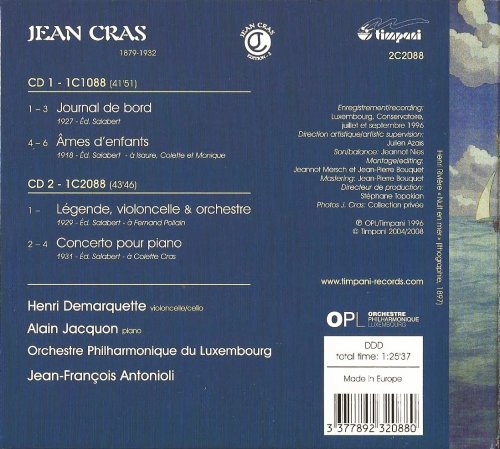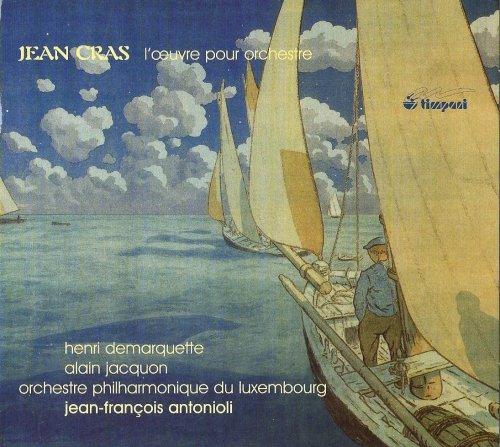
Orchestre Philharmonique du Luxembourg, Jean-François Antonioli - Jean Cras: Orchestral Works (2008) CD-Rip
- Title: Jean Cras: Orchestral Works
- Year Of Release: 2008
- Label: Timpani
- Genre: Classical
- Quality: FLAC (image+.cue,log,scans)
- Total Time: 01:25:37
- Total Size: 410 Mb
- WebSite: Album Preview
Tracklist:
Journal de Bord (Jean Cras)
01. I. Quart de 8 à minuit - 00:08:46
02. II. Quart de minuit à 4 - 00:06:49
03. III. Quart de 4 à 8 - 00:08:25
Âmes d'Enfants (Jean Cras)
04. I. Pures - 00:05:13
05. II. Naïves - 00:05:22
06. III. Mystérieuses - 00:07:14
Légende (Jean Cras)
07. Légende - 00:14:30
Piano Concerto (Jean Cras)
08. I. Lent - Modéré - Animé - 00:10:34
09. II. Très lent - 00:08:59
10. III. Très animé - 00:09:43
Performers:
Henri Demarquette - cello
Alain Jacquon - piano
Orchestre Philharmonique du Luxembourg
Jean-François Antonioli - conductor

Journal de Bord (Jean Cras)
01. I. Quart de 8 à minuit - 00:08:46
02. II. Quart de minuit à 4 - 00:06:49
03. III. Quart de 4 à 8 - 00:08:25
Âmes d'Enfants (Jean Cras)
04. I. Pures - 00:05:13
05. II. Naïves - 00:05:22
06. III. Mystérieuses - 00:07:14
Légende (Jean Cras)
07. Légende - 00:14:30
Piano Concerto (Jean Cras)
08. I. Lent - Modéré - Animé - 00:10:34
09. II. Très lent - 00:08:59
10. III. Très animé - 00:09:43
Performers:
Henri Demarquette - cello
Alain Jacquon - piano
Orchestre Philharmonique du Luxembourg
Jean-François Antonioli - conductor
These CD's present Cras's complete orchestral works, minus his "Andante religieux," which is still in manuscript. Here, Cras's style is not really "impressionist", but more a mixture of late-20th century French romanticism with touches of impressionism. The music is sort of in the vein of D'Indy, Magnard or Tournemire, with fleeting influences from Debussy and Ravel, but without really sounding like any of them. Cras eschews academic form, and allows his materials to find their own shapes, somewhat like late Debussy. Although some movements are melancholy or mysterious, the clouds are never terribly dark, and Cras's accustomed optimism constantly reasserts itself.
There's a good deal of whole-tone harmony, and modal, pentatonic and other exotic scales picked up by the composer on his shipboard travels (he was a career naval officer). Annotator Michel Fleury's description of Cras as "the Pierre Loti of music" is particularly apt--Loti the literary man was a naval officer too.
"Journal de bord"--"Ship's Log"--is not, as one might anticipate, "La Mer II." Debussy's work is a glittering description in third person, whereas Cras's is a less "showy" first person response to nature. One hears his personal reaction to the sea, not Debussy's wealth of onomatopoeic detail. After an atmospheric first movement which rises to a climax, and the modal sea-nocturne of the middle movement, the finale opens with ship engines rumbling in the bass. As we sight land, exotic solos in the woodwinds lead to a gesture of undisguised exultation in the brass and strings, very similar to a motif from Satie's "Parade". Dance rhythms alternate with contemplation of the vast expanses of the sea.
"Âme des enfants" ("Children's Souls") is a group of three pieces--one for each of his three daughters, Isaure, Colette, and Monique. Subtitled "Pure," "Naive" and "Mysterious," these are never "cutsey" in tone. The "mysteriousness" of the last movement manifests itself in melodic ostinati resembling those of Hermann's "Vertigo", but without the sinister elements. The close blends materials from the other movements with veiled references to "Frère Jacques".
"Légende" for cello and orchestra opens in a brooding tone, leads to a short cadenza for the soloist, and then to a long-breathed Franckian song. Throughout, there are strong and fluid contrasts of mood, often with modal folk-song like melodies. Cras explores the technique of the instrument--legato song, rapid passage-work, pizzicato, double stops--all played beautifully in tune by the soloist, Henri Demarquette.
Cras composed his "Piano Concerto" (one of his last works) for his daughter, Colette, who became the wife of composer Alexandre Tansman. Although the "solo" part requires a well-developed technique, the concerto is not really a flashy virtuoso vehicle. Often, the pianist functions as "primus inter pares", somewhat in the manner of a concerto grosso. It opens with great fanfares in the brass. Ceremonious "spit and polish" alternates with an almost (but not quite) jazzy impudence. The opening of the middle movement establishes and maintains a slightly eerie feeling with whole tone harmonies and melodies derived from exotic scales. The finale rouses us out of reverie with a military "reveille" from the trumpets. There are several jig-like episodes and an extensive passage for the soloist in pentatonic scales, as typical of the folk music of Cras's native Brittany as of the Orient.
Throughout, the Orchestra Philharmonique du Luxembourg responds flexibly to the sure-handed and expressive leadership of conductor Jean-François Antonioli.
As usual, Timpani's packaging compliments the music. The triple-fold cardboard album opens to reveal a handsome portrait of the composer in uniform--a sepia-tone photo signed to his daughter, Isaure. Once again, the cover art is a print by Henri Rivière, whose style, influenced by Japanese prints, offers an analogue to Cras's often exotically-inspired idiom.
Recommended to those with a predilection for late French romantics and who share the composer's taste for the exotic.
There's a good deal of whole-tone harmony, and modal, pentatonic and other exotic scales picked up by the composer on his shipboard travels (he was a career naval officer). Annotator Michel Fleury's description of Cras as "the Pierre Loti of music" is particularly apt--Loti the literary man was a naval officer too.
"Journal de bord"--"Ship's Log"--is not, as one might anticipate, "La Mer II." Debussy's work is a glittering description in third person, whereas Cras's is a less "showy" first person response to nature. One hears his personal reaction to the sea, not Debussy's wealth of onomatopoeic detail. After an atmospheric first movement which rises to a climax, and the modal sea-nocturne of the middle movement, the finale opens with ship engines rumbling in the bass. As we sight land, exotic solos in the woodwinds lead to a gesture of undisguised exultation in the brass and strings, very similar to a motif from Satie's "Parade". Dance rhythms alternate with contemplation of the vast expanses of the sea.
"Âme des enfants" ("Children's Souls") is a group of three pieces--one for each of his three daughters, Isaure, Colette, and Monique. Subtitled "Pure," "Naive" and "Mysterious," these are never "cutsey" in tone. The "mysteriousness" of the last movement manifests itself in melodic ostinati resembling those of Hermann's "Vertigo", but without the sinister elements. The close blends materials from the other movements with veiled references to "Frère Jacques".
"Légende" for cello and orchestra opens in a brooding tone, leads to a short cadenza for the soloist, and then to a long-breathed Franckian song. Throughout, there are strong and fluid contrasts of mood, often with modal folk-song like melodies. Cras explores the technique of the instrument--legato song, rapid passage-work, pizzicato, double stops--all played beautifully in tune by the soloist, Henri Demarquette.
Cras composed his "Piano Concerto" (one of his last works) for his daughter, Colette, who became the wife of composer Alexandre Tansman. Although the "solo" part requires a well-developed technique, the concerto is not really a flashy virtuoso vehicle. Often, the pianist functions as "primus inter pares", somewhat in the manner of a concerto grosso. It opens with great fanfares in the brass. Ceremonious "spit and polish" alternates with an almost (but not quite) jazzy impudence. The opening of the middle movement establishes and maintains a slightly eerie feeling with whole tone harmonies and melodies derived from exotic scales. The finale rouses us out of reverie with a military "reveille" from the trumpets. There are several jig-like episodes and an extensive passage for the soloist in pentatonic scales, as typical of the folk music of Cras's native Brittany as of the Orient.
Throughout, the Orchestra Philharmonique du Luxembourg responds flexibly to the sure-handed and expressive leadership of conductor Jean-François Antonioli.
As usual, Timpani's packaging compliments the music. The triple-fold cardboard album opens to reveal a handsome portrait of the composer in uniform--a sepia-tone photo signed to his daughter, Isaure. Once again, the cover art is a print by Henri Rivière, whose style, influenced by Japanese prints, offers an analogue to Cras's often exotically-inspired idiom.
Recommended to those with a predilection for late French romantics and who share the composer's taste for the exotic.

Classical | FLAC / APE | CD-Rip
As a ISRA.CLOUD's PREMIUM member you will have the following benefits:
- Unlimited high speed downloads
- Download directly without waiting time
- Unlimited parallel downloads
- Support for download accelerators
- No advertising
- Resume broken downloads


